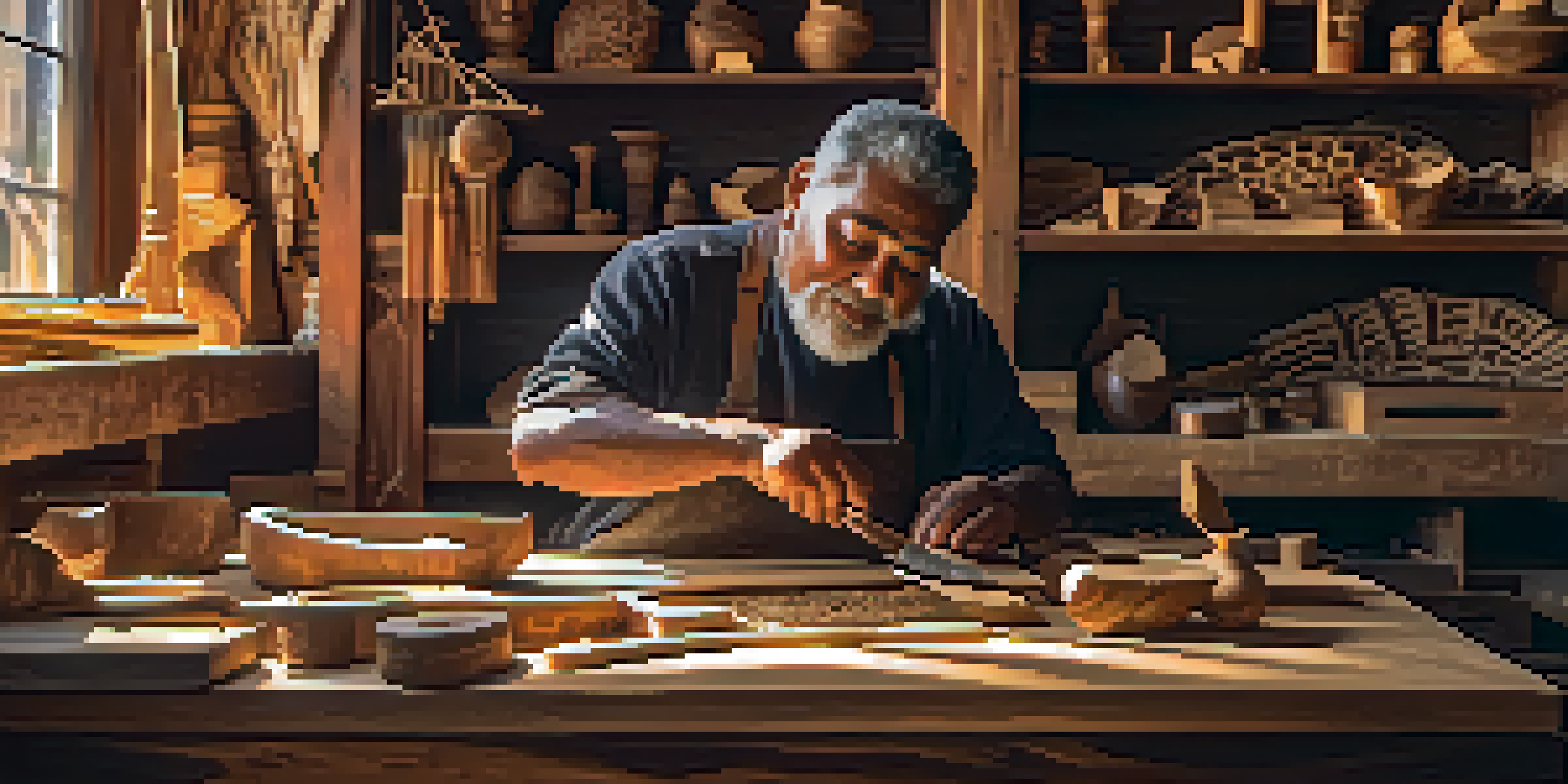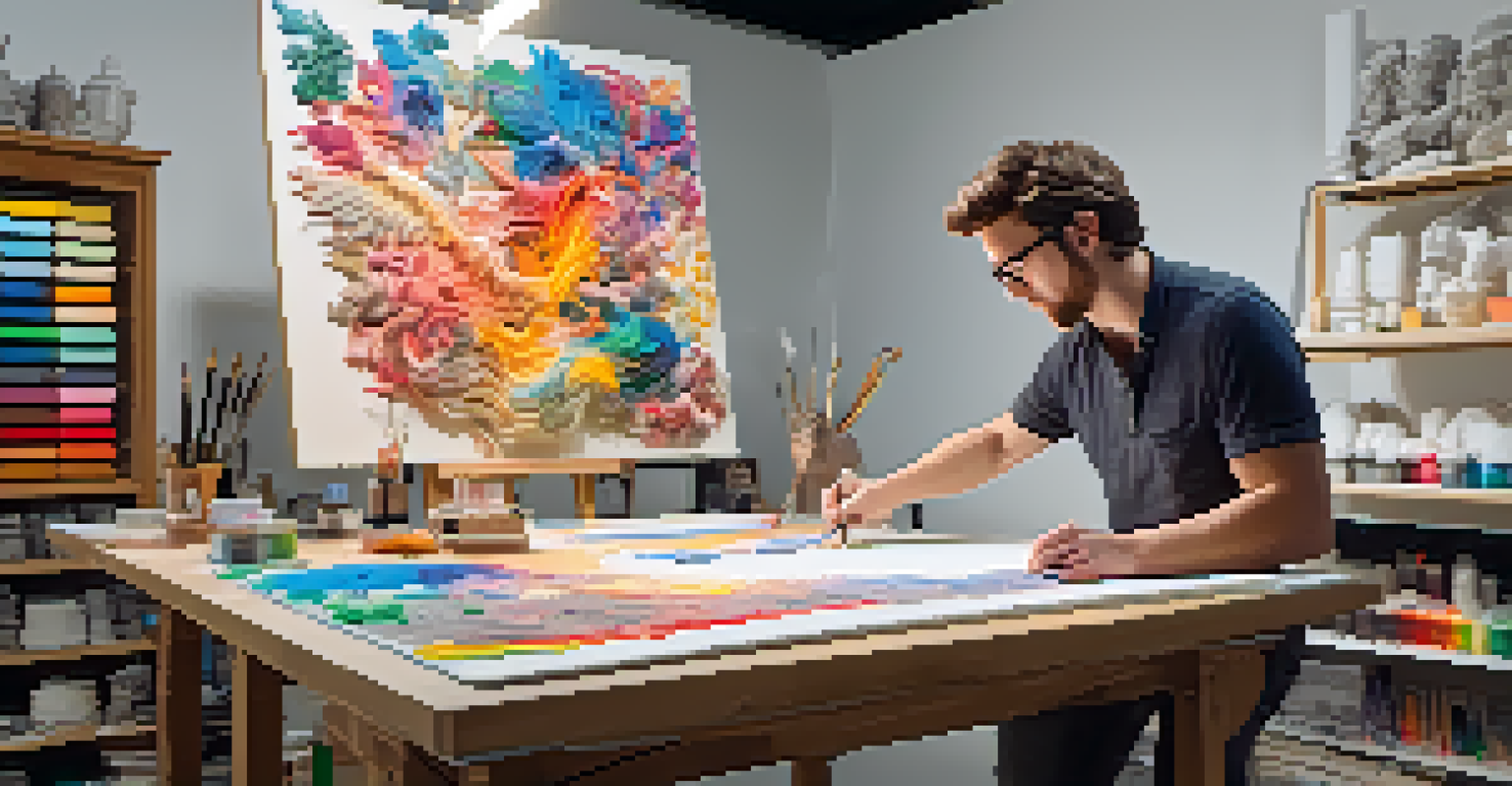Representation of Carving in Cultural and Mythological Texts

The Art of Carving: A Cultural Touchstone
Carving, as a form of artistic expression, has been a cornerstone in various cultures around the world. From the intricate wooden masks of African tribes to the delicate stone carvings of ancient civilizations, the art of carving transcends mere aesthetics. It's a powerful medium that communicates cultural identity, values, and beliefs, often telling stories that have been passed down through generations.
Art is not what you see, but what you make others see.
In many societies, carving is not just an art form but a rite of passage. For instance, in some Indigenous cultures, young members might undergo training in carving to connect with their heritage and understand their place within the community. This hands-on experience fosters a deep appreciation for the skills involved and reinforces cultural narratives about ancestry and tradition.
Moreover, carvings often serve functional purposes, such as tools or ceremonial objects, which further embeds them in the daily lives of the people. Whether it's a totem pole telling the story of a tribe's history or a carved bowl used in rituals, these artifacts bridge the gap between the past and present, making carving a living component of cultural expression.
Mythological Significance of Carving
In many mythologies, carving is imbued with symbolic meanings that reveal deeper truths about existence. For example, in Greek mythology, the story of Pygmalion, a sculptor who falls in love with his creation, highlights the transformative power of art. This narrative not only showcases the act of carving but also explores themes of love, creation, and the relationship between the creator and the created.

Similarly, in Hindu mythology, the intricate carvings of deities on temples serve more than decorative purposes; they are visual narratives that convey spiritual teachings. Each figure and detail embodies specific attributes and stories, inviting worshippers to engage with the divine. This melding of art and spirituality reinforces the importance of carving as a means of storytelling within religious contexts.
Carving Reflects Cultural Identity
Carving serves as a powerful medium that communicates cultural identity, values, and beliefs across various societies.
The act of carving itself, often seen as a divine gift, is celebrated in various cultures. For instance, in some Pacific Islander traditions, the skill of carving is believed to be bestowed by ancestors, linking the carver to their forebears. Such beliefs not only elevate the status of the artist but also deepen the connection between the physical and spiritual realms.
Carving Techniques Across Cultures
The techniques of carving vary widely across cultures, each with its unique tools and styles that reflect local resources and aesthetics. In Asia, for instance, intricate jade carvings showcase the region's affinity for this precious stone, while in Scandinavia, wood carving has been a longstanding tradition, evident in Viking ships and runestones. These techniques are often passed down through generations, preserving the craftsmanship and cultural heritage.
Every artist was first an amateur.
In Africa, the use of masks in carving speaks volumes about the cultural significance attributed to these artifacts. Each mask is meticulously crafted to embody the spirit of ancestors, animals, or deities, serving roles in rituals and ceremonies. The techniques used in creating these masks often involve community collaboration, reinforcing social ties and shared cultural narratives.
Meanwhile, contemporary artists are blending traditional carving methods with modern influences, creating hybrid forms that challenge and expand cultural dialogues. This evolution demonstrates that while the roots of carving are steeped in history, the art form is still very much alive, adapting to the changing landscapes of culture and technology.
Carving as a Means of Cultural Preservation
Carving plays a crucial role in preserving cultural heritage, especially in communities facing the threat of globalization. By creating carvings that reflect their identity, artists serve as custodians of their history and traditions. This not only keeps their culture alive but also educates outsiders about their unique stories and values.
In many Indigenous communities, carving is a way to reclaim narratives that may have been lost or misrepresented. For example, contemporary Indigenous artists often create works that challenge stereotypes, using traditional techniques to convey modern messages. This act of carving becomes a form of resistance, asserting their identity in a rapidly changing world.
Carving Blends Tradition and Modernity
Contemporary artists are merging traditional carving techniques with modern influences, creating dynamic forms of cultural expression.
Moreover, workshops and community initiatives focused on carving help to pass on skills to younger generations. These programs foster pride in cultural identity and ensure that traditional practices are not forgotten. In this way, carving is not just about creating art; it's about nurturing a living legacy that connects past, present, and future.
Carving in Literature and Storytelling
Literature often brings the art of carving to life, using it as a metaphor for deeper themes. In many narratives, characters who carve may be depicted as creators or destroyers, highlighting the dual nature of artistic expression. This interplay can reflect the struggles of identity, purpose, and the impact of one's choices on the world.
For instance, in novels where characters engage in carving, the act can symbolize their journey of self-discovery. As they carve, they may confront their fears, desires, and past traumas, transforming raw materials into meaningful expressions of their inner lives. This metaphor resonates with readers, illustrating how art can be a powerful tool for personal growth.
Additionally, storytelling traditions often incorporate carving as a means of preserving history. Tales of legendary carvers who created powerful artifacts or symbols serve as reminders of the importance of this craft in cultural memory. These stories not only celebrate the skill of carving but also emphasize its role in shaping collective identities.
Modern Interpretations of Carving
In today's world, carving continues to evolve, blending traditional methods with contemporary themes. Many artists are now experimenting with new materials and technologies, such as 3D printing, to push the boundaries of carving. This fusion of the old and the new opens up exciting possibilities for artistic expression and cultural commentary.
Moreover, modern interpretations of carving often address social issues, using art as a platform for advocacy. By incorporating themes of identity, heritage, and environmental concerns into their work, contemporary carvers engage audiences in meaningful conversations. This evolution demonstrates that carving is not just a relic of the past but a vibrant form of expression that speaks to current realities.
Carving Preserves Cultural Heritage
Through community initiatives and storytelling, carving plays a crucial role in preserving cultural heritage and educating future generations.
Exhibitions and installations featuring carved works have also gained popularity, allowing artists to reach broader audiences. These events often highlight the stories behind the carvings, inviting viewers to connect with the cultural significance of the art. Through these modern interpretations, carving remains a vital and dynamic form of cultural expression.
The Future of Carving in Cultural Narratives
As we look to the future, the role of carving in cultural narratives is poised to transform further. With the rise of digital platforms and social media, artists can share their work with a global audience, fostering cross-cultural exchanges and collaborations. This connectivity can lead to a richer understanding of carving's significance across different cultures.
Additionally, as communities continue to grapple with the impacts of globalization, carving may become an even more vital means of asserting cultural identity. Artists may increasingly turn to their heritage for inspiration, creating works that reflect both tradition and contemporary issues. This blend can help preserve cultural narratives while also making them relevant in today's world.

Ultimately, the future of carving is not just about the techniques or materials used; it's about the stories that continue to be told. Each carving holds the potential to bridge the past and present, connecting individuals and communities through shared experiences and values. As long as there are stories to tell, carving will remain an essential part of cultural expression.